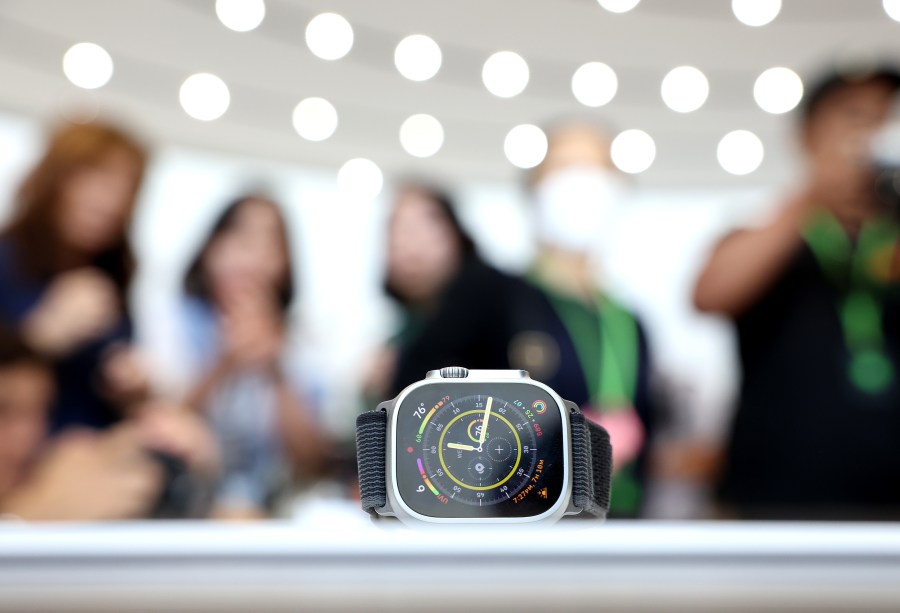Smart rings, air-purifying masks and hearables — the wearable tech trends to watch in 2023

As we wind down the year, we didn’t want to miss the opportunity to look back at some notable tech trends and maybe predict a few, especially those in the ever-growing wearable tech market.
Smartwatches are much more common these days, but “wearable” is starting to expand beyond the gadgets you strap to your wrist. Marketplace’s Kimberly Adams spoke with Victoria Song, a wearable technology reviewer for The Verge, who explained what’s on the horizon for this stuff in the coming year.
The following is an edited transcript of their conversation.
Victoria Song: You know, obviously smartwatches and fitness bands are the things that most people think of, but there’s actually stuff like smart rings that are out there. I would say the most famous one is probably the Oura ring. It’s a sleep tracker. A ton of celebrities use it. And then there’s also the Dyson Zone, which is a $950 wearable, air-purifying mask that connects to a pair of noise canceling headphones. If you wear it, you look like Bane, the “Batman” villain. You know, those are just two extreme ends, and somewhere in the middle we also have hearables. They’re basically little wearable devices that go in your ear, and they help you hear better. There’s just a lot of different things. They can look like things that aren’t things you might think of as tech, but anything that you can wear on your body, technically that’s wearable tech.
Kimberly Adams: “Hearables,” that’s a term I haven’t heard yet. The [Food and Drug Administration] relatively recently approved over-the-counter hearing aids. Is that where hearables come in?

Song: Actually, hearables have been around for a while. But yes, the over-the-counter hearing aid ruling has just, it’s just going to blur the line even further. But, a hearable is any piece of technology that you put in your ear that helps you hear better. So technically, AirPods could be considered a hearable because they have hearing-accessibility features. Like one of them is called Conversation Boost. And when you’re talking in a loud area, it’ll, you know, amplify the sound of the person you’re talking to so you can hear them better. It’s very similar in function to a hearing aid. But it’s not a hearing aid. Because you can’t call something a hearing aid without FDA clearance. Hearing aids are a regulated medical device.
Adams: I want to go back to that Dyson mask you were talking about. I was very entertained by your review of the Dyson Zone — part air purifier, part noise canceling headphones. Is something like that an outlier of wearable tech, or do you think it’s a signal of trends to come?
Song: It’s a little bit of both. Like right now, it’s an outlier because most people are not going to shell out $950 for something that’s very experimental. And also just, you know, there’s a lot of social stigmas and different types of social norms that come into play with wearable gadgets. Because any tech that you wear on your face that obscures your face, that creates like this primal sense of distrust. That’s why it’s an outlier. And it’s also very hard to mass produce something like that to fit a wide variety of faces. My face is different from your face, which is different from, you know, your friend’s face. It’s very difficult to mass produce those kinds of gadgets. But they are kind of the next wave of wearables. So there’s, like, two categories we can see them going off to. One is biometrics and the other is technology like AR glasses, augmented reality glasses, or [virtual reality] headsets. These are things that you put on your face, and it puts a layer of technology between you and the world. And it’s the same thing with the Dyson Zone. It is where we’re heading. We’re just not going to get there anytime soon.
Adams: One of the things that comes up a lot with wearable devices is privacy. What about consumers who are interested in wearable tech, but also want some guaranteed measure of privacy? Have you seen any wearables that cater to that?
Song: Unfortunately, no. There’s no one wearable device that I can point you towards and be like, “You will be 100% guaranteed to have privacy.” Part of that is because each company has their own privacy policy in terms and conditions. And, you know, third-party apps play into this as well. Let’s say you buy the Apple Watch, and you’re buying the Apple Watch because you believe that Apple is really committed to privacy, which they have publicly said that they are. And then you’re like, “Oh, I also use the running or fitness app Strava for, you know, collecting a lot of data and interacting with all of my athlete friends.” Well, you’re going to connect those two, you’re going to connect Strava through the Apple HealthKit. And that means Strava now has your data as well. And you have to agree to Strava’s privacy policies, which may or may not be as strong as Apple’s. And I’m just using Strava as an example here. But there are hundreds, thousands of third-party apps that you could link to your Apple Watch. And you don’t control what they do with your data. It’s a nasty little web of what happens with your data after you’ve given permission, so it’s tricky.
Adams: What is a wearable tech trend that you’re watching and most excited about going into 2023?
Song: I would actually say going into 2023, I’m most excited about the over-the-counter hearing aids market. It’s new, and it’s confusing. There’s bound to be drama in some sense, in this case regulatory drama. There’s just a lot of products out there, and how they market themselves as hearing aids or are they going to market themselves as personal sound-amplification products? You have consumers who are going to be new to this, going to retail stores trying to figure out what is best for their mild-to-moderate hearing loss. And I think that’s just going to be superinteresting to see which companies decide to enter that market. Like we’ve already seen Sony and Bose and some other big consumer tech brands kind of dip their toe in this arena. So it’s just gonna be really, really fun — well, fun for me, maybe not so fun for consumers to see how the line between hearing aids, headphones and hearables just blurs together.
Adams: We’re in the last little bit of time before holiday shopping for many people. Is there any particular wearable tech that you’d recommend for someone who’s on a budget or maybe needs a very-last-minute gift?
Song: So the good thing about wearables is that these used to be really luxury gadgets costing like $400, $500. But there’s actually a lot of solid entry-level budget options for people who are just looking to get started. Like if you’re on an iPhone, the best wearable you can get someone as a gift is an Apple Watch, it just is. But there’s different price levels for them now, like they just released the new second [generation] SE, and I really recommend that device as an entry-level gateway smartwatch for someone who doesn’t know whether they actually want one of these things or what type of device they want. It’s $250. If you can find it on sale, it might be for less. And the other trick that I give people is if you’re OK using a slightly older generation of device, look into refurbished markets because you can find higher-quality materials like the stainless steel instead of the aluminium for much cheaper than buying new. And it’s environmentally safe, and it’s still a really great gift. So I would check there.
Adams: My last three phones were refurbished.
Song: Yeah, there you go. See like, it’s a hack that we use as gadget reviewers. Also open box. Just look for eBay for open box stuff. It’s how you find it last minute for prices that aren’t so bad.
The future of this podcast starts with you.
Every day, the “Marketplace Tech” team demystifies the digital economy with stories that explore more than just Big Tech. We’re committed to covering topics that matter to you and the world around us, diving deep into how technology intersects with climate change, inequity, and disinformation.
As part of a nonprofit newsroom, we’re counting on listeners like you to keep this public service paywall-free and available to all.
Support “Marketplace Tech” in any amount today and become a partner in our mission.


















